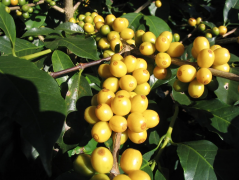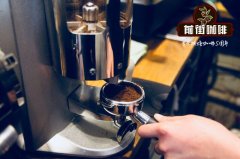Understand the importance of coffee roasting maturity how to judge coffee maturity according to taste
Simply put, roasting maturity is one of the things you must know and know about coffee. Maturity determines the flavor, color and texture of each coffee.
It is unscientific to judge the maturity by the appearance color of coffee.
Maturity can be as light as fingerprints to convey unique producing characteristics and raw bean treatment, which will give you a crisp citrus, delicate floral or rich berry flavor. Generally speaking, people usually equate this baking method with boutique coffee, which is also the ideal state pursued by many roasters.
In turn, maturity can be completely charred, and the taste of coffee from all places of origin is replaced by the roasted taste, which even a latte made into 12oz can pierce your soul.
Of course, when you make a mistake, maturity may die halfway, and your coffee is not mature enough, sharp or raw wheat, which will make you chagrin and regret.
So as a roaster, how do you judge that the maturity reaches the ideal state, and how do you avoid the deviation of coffee maturity?
For a long time, people have judged the maturity by the appearance color of coffee. Before learning to collect data, bakers rely most on, and most easily on, color. At that time, people would let the coffee continue to bake until the brown color of the coffee reached the standard (at that time, this was called "professional").
-Light brown means "immature"
-medium brown means "mature"
Dark brown means "overmature"
It's simple?
But that's not the case. Because to some people it is medium brown, to others it is dark brown or light brown. Because the judgment of color is completely subjective, it all depends on an individual's judgment of the degree of brown. So even if the appearance is dark brown, the coffee may be immature and sour, because the color of the bean noodles is also important. Just like grilled steak, the ratio of time to heat must be accurate, otherwise even if the steak looks well-done, the noodles are still raw.
With the progress of the industry and the application of more science and technology, people begin to realize that the method of "how dark brown is" is unscientific, unquantifiable, and can not really reflect the complex chemical reactions that take place in the baking process.
Even today, there is no unified measure of "light", "medium" and "deep" in the world, because maturity is not entirely reflected in color, its real embodiment lies in taste.
How to judge the maturity of coffee according to its taste?
The evaluation standard brought to you today is very rough and general, but it has a certain reference significance.
Now taste your coffee. Your coffee is:
-tart, grass or raw wheat = "immature"
-balanced, round, well-structured = "mature"
-too bitter, burnt or "too strong" = "overmature"
Of course, for many roasters (or coffee lovers), our description of "overmaturity" is seen as a positive taste. What I want to say about this is that "overmaturity" may be caused by mistakes, or it may be deliberately and carefully designed.
Therefore, we need to redefine maturity, rather than simply using "not" or "excessive". I think it should be a different style of maturity.
In other words, to achieve the ideal maturity, we must carefully design the baking curve to transform the structure of the coffee beans to a certain extent to ensure that the coffee can bring out the desired flavor.
Simply put, maturity refers to the completeness of baking relative to the goal.
The goal is an important criterion for us to judge whether baking is successful or not. Every job has a goal, and so is baking. Everyone also has their own goals when roasting or cup testing. for example, the same coffee tastes bright and superior in one person, but the acidity is good in another person, but the whole is not good enough.
Why?
Yeah, that's the target.
So the first question that bakers have to answer is, when setting the baking curve, think about why your supplier bought this bean from this place of origin. Is it supposed to have a fruity flavor? Or is it supposed to taste bright, list, with fresh citrus aromas? Or is it supposed to be thick and chocolate-scented? In addition, is this coffee supposed to be Italian, milk-based or drip-filtered? Should it be a single item or should it be used for matching?
What I want to say is that there is no ideal maturity in the world. As a baker, your success depends entirely on whether your baked product meets your expectations. It is important to keep in mind that even coffee from the same origin, the expected goals of each roaster are different. Coffee blended by some roasters should be made by others. Coffee from one place should have a taste of green apricot, but others should have a taste of dark fruit and milk chocolate. It all depends on your goal and whether you can achieve it.
Important Notice :
前街咖啡 FrontStreet Coffee has moved to new addredd:
FrontStreet Coffee Address: 315,Donghua East Road,GuangZhou
Tel:020 38364473
- Prev

The Origin of Brazilian Yellow bourbon Coffee beans description of the flavor and taste of yellow bourbon coffee beans in Queen's Manor
The average variety of coffee turns red when it ripens, while the yellow bourbon is famous for its yellow ripe fruit, which is regarded as a precious variety in Brazil. This variety has been highly appreciated by coffee buyers and bean bakers in recent years, in part because of its unique and high-quality flavor.
- Next

The secret of a perfect Espresso? Better, cheaper, greener Espresso?
Nowadays, most of the drinks in boutique coffee shops are based on Espresso coffee, whether it is Americano, Latte or a cup of Espresso Martini, they are all based on Espresso. However, cooking a cup of Espresso is also the most complicated, which involves too many combinations and influencing factors, such as the choice of coffee beans and grinding.
Related
- Beginners will see the "Coffee pull flower" guide!
- What is the difference between ice blog purified milk and ordinary milk coffee?
- Why is the Philippines the largest producer of crops in Liberia?
- For coffee extraction, should the fine powder be retained?
- How does extracted espresso fill pressed powder? How much strength does it take to press the powder?
- How to make jasmine cold extract coffee? Is the jasmine + latte good?
- Will this little toy really make the coffee taste better? How does Lily Drip affect coffee extraction?
- Will the action of slapping the filter cup also affect coffee extraction?
- What's the difference between powder-to-water ratio and powder-to-liquid ratio?
- What is the Ethiopian local species? What does it have to do with Heirloom native species?

